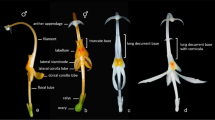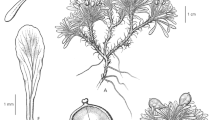Abstract
Alysicarpus Necker ex Desvaux (Fabaceae, Desmodieae) consists of \(\sim \)30 species that are distributed in tropical and subtropical regions of the world. In India, the genus is represented by ca. 18 species, of which seven are endemic. Sequences of the nuclear Internal transcribed spacer from 38 accessions representing 16 Indian species were subjected to phylogenetic analyses. The ITS sequence data strongly support the monophyly of the genus Alysicarpus. Analyses revealed four major well-supported clades within Alysicarpus. Ancestral state reconstructions were done for two morphological characters, namely calyx length in relation to pod (macrocalyx and microcalyx) and pod surface ornamentation (transversely rugose and nonrugose). The present study is the first report on molecular systematics of Indian Alysicarpus.




Similar content being viewed by others
References
Adema A. 2003 Notes on Malesian Fabaceae (Leguminosae-Papilionoideae) 10. The genus Alysicarpus. Blumea 48, 145–152.
Backer C. A. 1911 School flora voor Java. NV Welterverden.
Bailey C. D., Doyle J. J., Kajita T., Nemoto T. and Ohashi H. 1997 The chloroplast rpl2 intron and ORF184 as phylogenetic markers in the legume tribe Desmodieae. Syst. Bot. 22, 133–138.
Baker J. G. 1876 Order L. Leguminosae. In The flora of British India (ed. J. D. Hooker), vol. II. Sabiaceae to Cornaceae. Reeve, London.
Dhabe A. S. 2013 Identification of Alysicarpus Desv. taxa on the basis of bracts and calyx. Bioinfolet 10, 1082–1090.
DNA Baser Sequence Assembler v4 2013 Heracle Biosoft SRL. http://www.DnaBaser.com.
Dudik N. M. 1981 Morphology of the pods of Leguminales (Fabales). In Advances in legume systematics (ed. R. M. Polhill and P. H. Raven), part 2, pp. 897–901. Royal Botanic Gardens, Kew, UK.
Dutt C. B. S., Daniel M. and Sabnis S. D. 1979 Chemotaxonomical studies on the genus Alysicarpus Neck ex Desv. Indian J. Bot. 2, 45–50.
Gholami A. and Pandey A. K. 2016 Alysicarpus gautalensis (Leguminosae: Desmodieae), a new species from Maharashtra, India. Phytotaxa 266, 141–145.
Gillett J. B. 1971 Leguminosae, Subfamily Papilionoideae. In Flora of tropical east Africa (ed. J. B. Gillett, R. M. Polhill and B. Vercourt), part 1–2, pp. 1–1109. Crown Agents, London, UK.
Guindon S. and Gascuel O. 2003 A simple, fast and accurate algorithm to estimate large phylogenies by maximum likelihood. Syst. Biol. 52, 696–704.
Huelsenbeck J. P. and Ronquist F. 2001 MrBAYES: Bayesian inference of phylogeny. Bioinformatics 17, 754–755.
John C. K. and Thengane R. J. 1994 Relationship between nuclear DNA content and speciation in Alysicarpus. Cytologia 47, 167–177.
Kajita T., Ohashi H., Tateishi Y., Bailey C. D. and Doyle J. J. 2001 rbcL and legume phylogeny, with particular reference to Phaseoleae, Millettieae and allies. Syst. Bot. 26, 515–536.
Lewis G., Schrire B., Mackinder B. and Lock M. 2005 Legumes of the World. Royal Botanical Gardens, Kew.
Maddison W. P. 1995 Calculating the probability distributions of ancestral states reconstructed by parsimony on phylogenetic trees. Syst. Biol. 44, 474–481.
Maddison W. P. and Maddison D. R. 2009 Mesquite: a modular system for evolutionary analyses, version 2.72 (http://mesquiteproject.org).
Pagel M., Meade A. and Barker D. 2004 Bayesian rstimation of an-cestral character states on phylogenies. Syst. Biol. 53, 673–684.
Patil R., Solunke S. and Pokle D. 2013 Enumeration of leaf architecture in the genus Alysicarpus Desv. DAV Int. J. Sci. 2, 81–84.
Pedley L. 2001 Alysicarpus (Leguminosae: Desmodieae) in Australia: a taxonomic revision. Austrobaileya 6, 107–116.
Peng C. I. and Chaw S. M. 1986 Alysicarpus rugosus (Willd.) DC., A newely naturalised legume species in Taiwan. Bot. Bull. Acad. Sin. 27, 247–253.
Pokle D. S. 1998 Color variation in the flowers of Alysicarpus Desv. Int. J. Mendel 15, 89–90.
Pokle D. S. 2002 Synopsis of Alysicarpus Desv. in India. In Perspectives of plant biodiversity (ed. A. P. Das), pp. 471–481. Bishen Singh Mahendra Pal Singh, Dehra Dun, India.
Posada D. 2008 jModel Test. Phylogenetic model averaging. Mol. Biol. Evol. 25, 1253–1256.
Pramanik A. and Thothathri K. 1982 Taxonomic notes on the genus Alysicarpus Desv. (Leguminosae). Bull. Bot. Surv. India 24, 112–113.
Raven P. H. and Polhill R. M. 1981 Biogeography of the Leguminosae. In Advances in legume systematics (ed. R. M. Polhill and P. H. Raven), part 1, pp. 27–34. Royal Botanic Gardens, Kew, UK.
Ronquis F. and Huelsenbeck J. P. 2003 Mr BAYES 3: Bayesian phylogenetic inference under mixed models. Bioinformatics 19, 1572–1574.
Sanjappa M. 1992 Legumes of India. Bishen Singh Mahendra Pal Singh, Dehra Dun, India.
Schluter D., Price T., Mooers A. O. and Ludwig D. 1997 Likelihood of ancestor states in adaptive radiation. Evolution 51, 1699–1711.
Stamatakis A. 2006 Raxml-vi-hpc: maximum likelihood-based phylogenetic analyses with thousands of taxa and mixed models. Bioinformatics 22, 2688–2690.
Swofford D. L. and Maddison W. P. 1987 Reconstructing ancestral character states under Wagner parsimony. Math Biosci. 87, 199–229.
Subramaniam S., Pandey A. K., Geeta R. and Mort M. E. 2013 Molecular systematics of Indian Crotalaria (Fabaceae) based on analyses of nuclear ribosomal ITS DNA sequences. Plant Syst. Evol. 299, 1089–1106.
Subramaniam S., Pandey A. K. and Rather S. A. 2015 A revised circumscription of the species in Bracteatae complex (section Calycinae) in the genus Crotalaria L.: evidence from nuclear and chloroplast markers. Plant Syst. Evol. 301, 2261–2290.
Thompson J. D., Gibson T. J., Plewniak F., Jeanmougin F. and Higgins D. G. 1997 The ClustalX windows interface: flexible strategies for multiple sequence alignment aided by quality analyses tools. Nucleic Acids Res. 25, 4876–4882.
Webster A. J. and Purvis A. 2002 Ancestral states and evolutionary rates of continuous characters. In Morphology, shape and phylogeny (ed. N. McLeod and P. L. Forey), pp. 247–268. Taylor and Francis, New York, USA.
Webster A. J., Gittleman J. L. and Purvis A. 2004 The life history legacy of evolutionary body size change in carnivores. J. Evol. Biol. 17, 396–407.
White T. M., Bruns T., Lee S. and Taylor J. 1990 Amplification and direct sequencing of fungal ribosomal RNA for phylogenetics. In PCR protocols: a guide to methods and applications (M. A. Innis, D. H. Gelfand, J. J. Sninsky and T. J. White), pp. 315–321. Academic Press, San Diego, USA
Yanthan M., Biate D. and Misra A. K. 2011 Taxonomic resolution of actinorhizal Myrica species from Meghalaya (India) through nuclear rDNA sequence analyses. Funct. Plant Biol. 38, 738–746.
Acknowledgements
Research and Development grant support to Arun K. Pandey from University of Delhi is thankfully acknowledged. We also thank Prof. S. R. Yadav, Prof. A. S. Dhabe, Prof. M. M. Sardesai, Dr S. P. Gaikwad, Dr R. D. Gore for their help in field collections. We are grateful to Dr Paramjit Singh, Director, Botanical Survey of India and in charge of different herbaria for permission to consult herbaria.
Author information
Authors and Affiliations
Corresponding author
Additional information
[Gholami A., Subramaniam S., Geeta R. and Pandey A. K. 2017 Molecular systematics of Indian Alysicarpus (Fabaceae) based on analyses of nuclear ribosomal DNA sequences. J. Genet. 96, xx–xx]
Corresponding editor: U. C. Lavania
Rights and permissions
About this article
Cite this article
Gholami, A., Subramaniam, S., Geeta, R. et al. Molecular systematics of Indian Alysicarpus (Fabaceae) based on analyses of nuclear ribosomal DNA sequences. J Genet 96, 353–363 (2017). https://doi.org/10.1007/s12041-017-0785-8
Received:
Revised:
Accepted:
Published:
Issue Date:
DOI: https://doi.org/10.1007/s12041-017-0785-8




